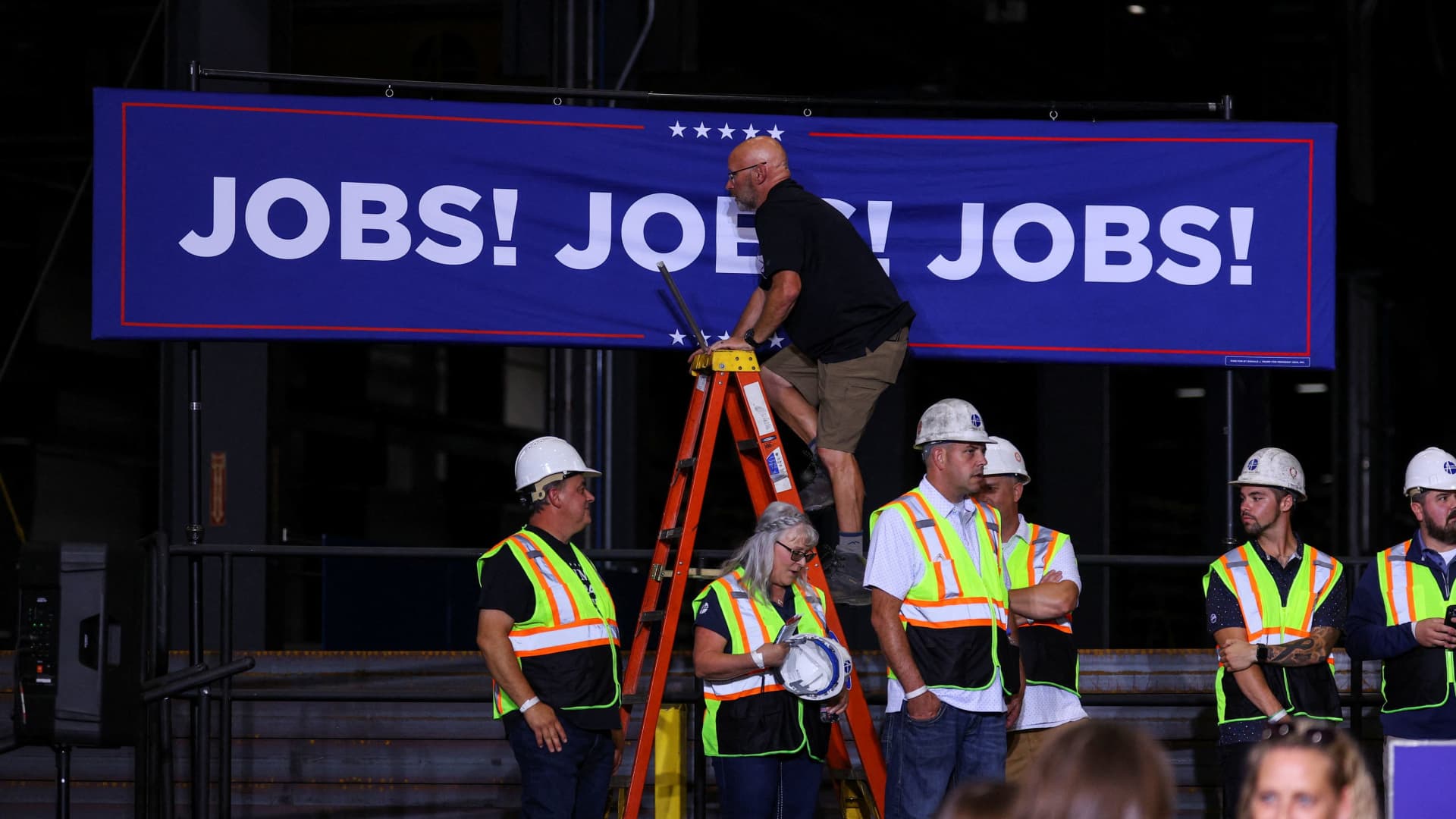[ad_1]

When Vice President Kamala Harris and former President Donald Trump take the debate stage in Philadelphia on Tuesday night, expect them to arrive with a stockpile of talking points about the U.S. economy.
In the weeks leading up to their head-to-head debate, hosted by ABC News, both Harris and Trump have unveiled new economic proposals. They have also tried to paint their rival as a threat to the health and stability of the U.S. economy.
As the candidates try to frame the economy in favorable terms Tuesday, keep these key numbers in mind.
Inflation and prices
People walk by a produce store in Brooklyn on August 14, 2024 in New York City.
Spencer Platt | Getty Images
- 1.4%: The Consumer Price Index in January 2021 at the start of the Biden-Harris administration. President Joe Biden has repeatedly claimed that he inherited a 9% inflation rate from Trump, which is false.
- 9.1%: The CPI in June 2022, the height of the post-pandemic inflation surge under Biden, and the highest rate since 1981. Trump has repeatedly claimed it was the highest inflation rate in U.S. history, but this is false.
- 2.9%: The annual CPI in July of this year, the most recent reading. This is the lowest 12-month inflation rate since March 2021. The next CPI report will be released Wednesday.
- 19.4% The cumulative increase in prices since Biden and Harris took office, according to a CNBC analysis of CPI data. Trump has falsely claimed that cumulative prices have soared more than 50% since Jan. 2021.
- 7.8%: The cumulative increase in prices over the four years Trump was in office, according to a CNBC analysis of CPI data over time.
Jobs and wages
A staff member stands on a ladder on the day of Republican presidential nominee and former U.S. President Donald Trump’s visit in Potterville, Michigan, U.S., August 29, 2024.
Brian Snyder | Reuters
- 14.8%: The unemployment rate in April 2020, the highest single month of the Trump administration, when employers hemorrhaged jobs due to Covid-19. This was also the highest monthly rate since the BLS first began tracking unemployment in 1948.
- 6.4%: The unemployment rate in January 2021, when Biden and Harris took office. This was the highest monthly rate of the Biden-Harris administration so far.
- 17.6%: The average hourly wage increase since Biden took office, according to a CNBC analysis of BLS data. Biden claims that wage growth outpaced inflation during his presidency, which is not true since prices have cumulatively increased by 19.4%.
- 15.9 million: The jobs created under the Biden-Harris administration so far, according to BLS data.
- 2.7 million: The net number of jobs lost during the Trump administration, a figure largely attributable to the pandemic-induced economic recession.
- 6.7 million: The jobs added from the time Trump took office in January 2017 until February 2020, just before the pandemic tanked the U.S. job market.
Deficits, spending and debt
An exterior view of the U.S. Capitol on September 9, 2024 in Washington, DC. Members of the Senate and U.S. House of Representatives return to the Nation’s capitol, following their August recess.
Kent Nishimura | Getty Images
- $8.4 trillion: The estimated net total spending by the Trump administration. This figure represents the amount Trump approved in gross ten-year borrowing, minus the amount he approved in deficit reduction, according to the nonpartisan Committee for a Responsible Federal Budget. If Covid-19 stimulus and relief packages are removed from the total, that number drops to $4.8 trillion.
- $4.3 trillion: The estimated net total spending during Biden’s first three years and five months in office, per the CRFB. Without the American Rescue Plan, Biden’s major pandemic stimulus package, the net total falls to $2.2 trillion.
- 39.1%: The percent increase of the U.S. national debt from Trump’s inauguration until the day of Biden’s inauguration, according to a CNBC analysis of figures from the Congressional Research Service.
- 30.6%: The percent increase in U.S. national debt from Biden’s inauguration day until this month, according to a CNBC analysis of Treasury data.
GDP
- 2.7%: The average annual growth rate of U.S. gross domestic product from 2017 to 2019, the first three years of Trump’s presidency before the Covid-19-induced economic crash, according to World Bank data. GDP measures the value of the goods and services that the U.S. produces.
- 3.4%: The average U.S. annual GDP growth rate from 2021 to 2023, the first three years of the Biden-Harris administration. This number was boosted by a hot 2021, stoked in part by the slew of pandemic-era stimulus packages passed by both Trump and Biden.
Stock market

The S&P 500 vs. the Dow Jones Industrial Average vs. the Nasdaq Composite since Trump’s inauguration day.
- 12.3%: Average return of the S&P 500 from 2021 to 2023, the first three years of the Biden-Harris administration, according to figures from Berkshire Hathaway.
- 16.3%: Average return of the S&P 500 from 2017 to 2019, the first three years of the Trump White House.
[ad_2]
Source link
